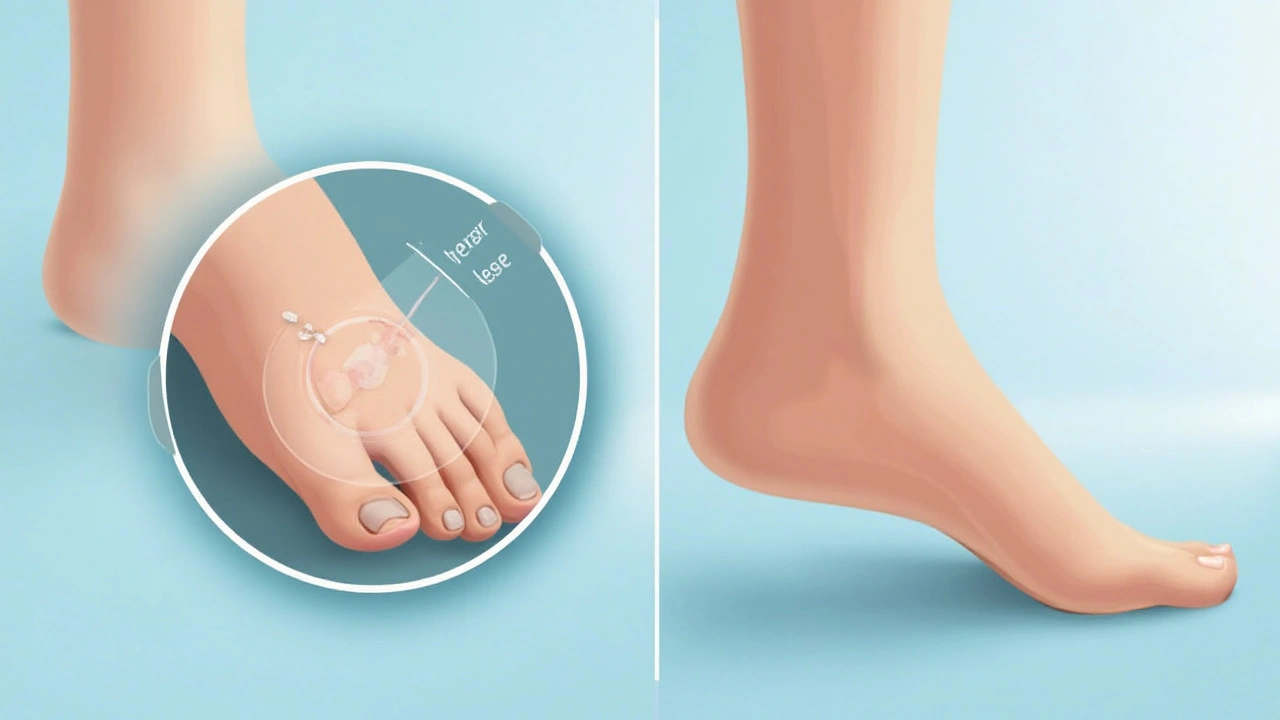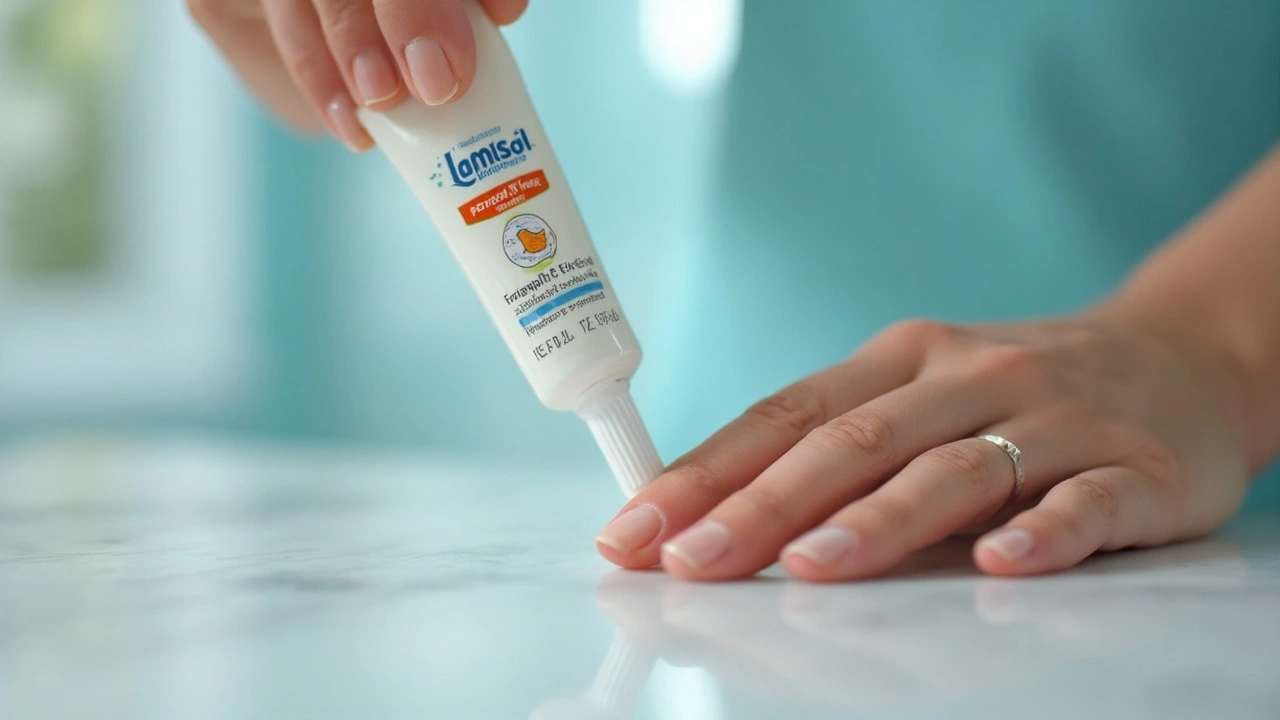If you’ve ever wrestled with the burning itch between your toes after a gym session, you know how persistent and annoying fungal infections can be. Even worse? They seem to laugh in the face of your best scrubbing efforts. That’s exactly where Lamisil steps in, packing a punch against some of the toughest skin and nail invaders. But here’s the thing—people often grab it from the pharmacy shelf without really knowing what makes it tick, how to make it work most effectively, or what to expect down the line. Let’s shine a bright light on the truth about this antifungal go-to.
What Is Lamisil and How Does It Fight Fungus?
Lamisil isn’t just another cream in your medicine cabinet. It’s the brand name for terbinafine, a molecule designed to hit fungal cells where it hurts: their cell membranes. The science is pretty wild—terbinafine blocks an enzyme (squalene epoxidase) used by fungi to make ergosterol, a fat that’s super important for their protective outer layers. Without ergosterol, the fungus basically falls apart and dies. People use it most often for athlete’s foot, but it also works against jock itch, ringworm, and those gnarly nail infections called onychomycosis.
You can find Lamisil in a few forms. There’s the classic cream for skin, sprays for hard-to-reach spots, gels that dry fast (especially nice between the toes), and oral tablets for those deep-rooted nail problems. Which one should you pick? Well, it depends on what’s infected. Got a skin rash? The cream or spray is usually enough. But if your toenails look like they’re turning into chalk, only the pill version can dig deep enough to clear it.
What makes Lamisil different from old-school antifungals like clotrimazole or miconazole is that it usually works faster. Some people feel relief from itching and redness in just a couple of days, though you need to complete the entire treatment course—otherwise, the fungus can just regroup and launch a comeback. Terbinafine has been around since the '90s and is one of the most studied antifungals in the world, so doctors know a lot about how it works and the safety risks. Pretty reassuring, right?
If you’re curious about how well it really works, several large studies found that terbinafine cream outperforms most other topical antifungal creams in head-to-head trials for common skin fungi. For nail infections, the oral tablets have a cure rate of about 70%—about twice as effective as some other medicines. So, if you’re tired of hiding your feet in public pools or keep dealing with embarrassing rashes, lamisil is a strong contender.
Common Uses: When Should You Reach for Lamisil?
Lamisil’s sweet spot is skin and nail infections caused by dermatophytes, which are a family of fungi that thrive in moist, warm places (think gym showers, sweaty socks, shared yoga mats). When your feet start peeling and burning after a workout, there’s a good chance you’re dealing with athlete’s foot (tinea pedis). For this, Lamisil cream or spray is usually all you need.
Jock itch (tinea cruris) and ringworm (tinea corporis) look different but are triggered by the same kind of fungi. The symptoms can show up as ring-shaped rashes or itchy patches that spread quickly. Lamisil cream makes short work of these, too. The key is applying it once or twice daily and not quitting just because the rash looks better—keep going for a week or so after symptoms fade to make sure the fungus is totally wiped out.
Nail fungus is another beast. It turns nails thick, crumbly, and yellow. The tricky thing is: creams can’t penetrate the dense nail plates, so you need to go with Lamisil tablets taken by mouth, and the treatment can last 6-12 weeks. It feels like forever, but patience really pays off here. People with diabetes or weak immune systems should see a healthcare provider before using oral terbinafine, since infections can be harder to treat and complications can pop up.
Here’s a weird fact—the fungus that causes athlete’s foot can actually spread to other areas, like your groin or underarms, through towels or your hands. So if you’re dealing with more than one rash, talk to your doctor about the best strategy. Sometimes a mix of creams and pills is needed to knock out extensive fungal invasions.
Using Lamisil to prevent fungal infections isn’t supported by most experts. It’s tempting to smear some on “just in case” after sharing locker rooms, but this increases resistance over time. Instead, stick to good hygiene, cotton socks, and “shower shoes” in public places to cut down your chances of getting infected in the first place.

How to Use Lamisil for Best Results
Even though Lamisil is available without a prescription in many countries, there’s an art to using it right. It’s not just about rubbing it in and forgetting about it. Start by washing and drying the related area thoroughly. Fungi adore moisture, so drying completely before putting on socks or shoes makes a big difference. For athlete’s foot, focus on the skin between the toes—most people only glaze over the top, missing the real hot spot for infection.
When you apply the cream, don’t just aim for the visible rash. You should rub it gently into about one inch of healthy-looking skin around the area, because that’s often where the fungus is lurking, waiting to spread. If you’re treating foot fungus, changing your socks at least once daily helps, and you should also give your shoes a breather—sunlight is a fungus’s worst enemy.
Stick to the schedule, usually once or twice daily for up to two weeks for skin infections, longer for nail infections if you’re using pills. Don’t skimp even if your symptoms improve within days. Skipping doses or stopping early is the number one reason people get recurring problems.
A lot of folks ask if they can use Lamisil alongside other medicines. Generally, the creams play nicely with most other products, but the oral tablets can mess with medications that affect your liver. It’s smart to double-check with your pharmacist or doctor if you take meds for blood pressure, heart rhythm, depression, or cholesterol.
Practical tip: If you’re treating nail fungus, try keeping your toenails short and filing down thickened areas when they get soft after a shower. This helps the pill treatment blast through to the root of the problem and gives you the best shot at getting clear, healthy nails again.
One thing you might not know—nail fungus survives on clippers, files, and shoes. Clean everything with hot water, and don’t share pedicure tools. That lingering fungal debris can easily launch a sneak attack if you let your guard down too soon.
Side Effects and Safety: What Should You Watch Out For?
Here’s the honest scoop: no medicine is perfect, and Lamisil is no exception. For most people, applying the cream means a few minutes of tingling or mild burning, which usually fades quickly and isn’t a reason to panic. If you see redness, swelling, or get blisters, you might have a sensitivity and should stop right away. Rarely, people get allergic rashes that spread—if this happens, get checked by a doctor.
The oral tablets are a different story. Since they get processed by your liver, you’ll want to avoid heavy drinking, and your doctor might want blood tests if you’ll be taking them for weeks. Some people notice taste loss, headache, mild stomach upset, or slight muscle aches. These usually go away, but any unexplained yellowing of the skin, dark urine, or strong nausea should be flagged immediately—it’s rare, but some have had serious liver reactions that needed quick attention.
Lamisil isn’t recommended for pregnant or breastfeeding women. Terbinafine crosses into breast milk, and while studies haven’t shown major harm, it’s better to avoid risks. Kids under age 12 should only use it if a doctor says it’s okay. If you have a history of liver disease, autoimmune disorders, or certain blood conditions, play it safe and talk to your provider before starting oral terbinafine.
Here’s another thing—fungal infections can mask other conditions. Sometimes, what looks like “just a rash” is actually eczema or even a skin reaction to an allergy. If the area looks unusual, is getting worse with treatment, or has pus, don’t just reapply more cream—check in with an expert.
Don’t forget that Lamisil, like other antifungals, can make the skin sensitive to the sun. If you’re starting treatment at the beginning of summer, cover up or use sunscreen on treated areas.

Tips to Prevent Fungal Infections (So You Don’t Need Lamisil Next Time)
Honestly, the best victory is never needing antifungals at all. Fungi are everywhere, but they love certain environments. If you’ve battled athlete’s foot, you know how stubborn it can be. These habits make a real difference:
- Change socks and underwear daily, especially after sweating.
- Let shoes dry out between uses; never wear the same pair two days in a row if you can help it.
- Pick breathable fabrics like cotton over synthetics—fungus hates airflow.
- Keep shower floors and bath mats clean, and avoid walking barefoot in public locker rooms.
- Don’t share towels, shoes, or nail clippers—fungi travel on gear.
- Keep skin folds dry, using powders or antifungal sprays as a barrier if you’re prone to sweating.
- Trim your nails straight across and keep them short to lower the risk of nail infection.
- If you notice your pets scratching or losing fur, get them checked, because ringworm can be passed from animals to humans.
Quick story: A dermatologist in Chicago once told her patients to freeze shoes they suspected were harboring fungus. Silly as it sounds, a night in the freezer can help kill off stubborn spores, as long as you pack shoes in a plastic bag. And it actually works for keeping recurrent athlete’s foot at bay—try it if you’re tired of the same old infections coming back again and again.
Skin gets thin and riskier as we age, so older adults may need to stay extra vigilant. People with diabetes or certain immune conditions are more likely to develop severe infections from the same fungus that causes a mild rash in healthy people. For this group, quick action and careful prevention work best.
Even with the world’s best hygiene, sometimes the fungus finds a way in. If you’re unlucky enough to face another itchy outbreak, you’ll know how to reach for Lamisil and give it the best chance at a fast knockout. But with these little changes, your odds get way better—and you might just be able to keep your feet sandal-ready all summer long.







Nicholas Blackburn
July 17, 2025 AT 22:17Look, I've seen tons of people waste their time on useless creams and home remedies when a proper medication like Lamisil is just the obvious go-to. If you’re serious about zapping fungal infections, stop dithering and use something that actually works. That article breaks it down well, but honestly, you should really focus on the safety tips because messing that up could just backfire big time.
For those out there ignoring side effects or mixing stuff willy-nilly, you’re setting yourself up for a disaster. And honestly, the way some folks blindly mess with dosages like they’re candy — it’s pathetic. Follow the script, don’t try to be a hero.
Also, grammar-wise, the article nails clarity, but don't let the casual tone fool you—this is serious business. Your nails and skin don't heal themselves, and fungus isn't some minor annoyance; it’s invasive and if untreated, well, you’re basically begging for a bigger mess.
Anyways, just use Lamisil properly or don’t complain when things get worse. Simple.
Dave Barnes
July 18, 2025 AT 18:06Ah, the eternal dance between health and medicine, where fungal foes fall to chemical allies like Lamisil. But isn’t it curious how many people forget the essence of healing is balance? Sure, the article provides a straightforward guide, but metaphorically, this is a reflection of our lives — battling what we don’t see to emerge shining.
I wonder though, how much of our faith in such medications is absolute versus a societal construct? Treat the surface rash and all is well, or is it the symptom of a deeper imbalance? Fascinating stuff. Anyone else think sometimes the best cure is awareness itself?
Anyway, for those fighting the fungal fight, the tips shared are practical. But remember, the human body isn’t just a problem to be solved but a story to be honored.
Brandi Thompson
July 19, 2025 AT 13:59Oh wow, another glowing review of a med practically shoved down our throats like it’s some magic bullet. Newsflash: Lamisil isn’t perfect, and the article conveniently glazes over potential nasties like liver risks and drug interactions. I’m tired of these sugarcoated health pieces hiding the truth beneath a veneer of 'zero fluff.'
It’s not just about slapping on a cream or popping a pill; lengthy, complicated side effects are waved off too easily. How many of you have felt awful after starting treatment but kept quiet because the pandemic of misinformation convinces you it’s the only route?
Honestly, if you want to use Lamisil, do your homework beyond pretty bullet points. Real facts, varied experiences, and honest discussions matter. Don’t buy the polished narrative without skepticism.
And yeah, a safety section doesn’t cut it when the risks are pruned down to a few sentences.
Chip Hutchison
July 20, 2025 AT 09:50This was quite an informative read on Lamisil! I really appreciate the straightforward approach to explaining how to use it safely, which is crucial given how many people misuse antifungal meds thinking they’re harmless. We all know fungal infections can be stubborn, so patience and proper application are key.
From a cultural standpoint, there’s sometimes stigma around fungal infections, especially on feet or nails, which can delay treatment. Articles like this help normalize the conversation and encourage folks to seek help. It’s not just about the medicine but about well-informed users who understand their conditions.
I'd encourage anyone considering Lamisil to consult healthcare professionals and maybe even check for underlying causes of infections. Remember, everyone's body responds differently, so personal caution and care are important.
Emily Moody
July 21, 2025 AT 05:41Alright, let's cut the niceties and speak plainly. Lamisil is a powerhouse antifungal, no doubt, but it’s not some patriotic little pill that saves the day without backup. You NEED to get this right or pay the price, which can get ugly.
Many out there underestimate the complexity of fungal infections, like they're just some trivial invader easily dispatched. They aren’t. And neither is the medication foolproof without rigorous adherence to the dose and duration prescribed — skipping days or trying to accelerate treatment is a recipe for resistance.
Also, safety isn’t just about avoiding side effects; it’s about national-level awareness of responsible drug use. We lose that sense of respect for meds, and next thing you know, you face superbugs that no one talks about now but will soon.
This article is a decent start but could have been firmer with warnings. Folks, treat fungal infections as seriously as you do any other health threat.
Prateek Kohli
July 22, 2025 AT 01:32I’m quite impressed with how this article presents Lamisil in a balanced way, highlighting both its effectiveness and the importance of cautious use. As someone from a country where fungal infections can often be ignored due to affordability or knowledge gaps, this kind of open info sharing is valuable.
It’s great that they include tips for safe use because misuse can lead to problems worse than the infection itself, like resistance or side effects. The article's no-fluff approach makes it easier for people to get the facts without feeling overwhelmed or patronized.
From my perspective, not only does the medication matter but how people access and understand it. Awareness campaigns alongside such articles could help bridge gaps in treatment globally. Have others had any interesting experiences using Lamisil?
Noah Seidman
July 22, 2025 AT 21:23Honestly, I’m skeptical. Lamisil, sure, it’s effective but people tend to believe in all these quick fixes without truly understanding the real root causes of fungal infections—hygiene, diet, immune health. Slapping on a cream or taking pills won’t fix the larger lifestyle factors that lead to recurring infections.
Articles like this sound great but lack the philosophical depth needed to grasp health as a holistic system. It’s just patching symptoms, not addressing core problems. That’s why many complain about recurrence even after treatment.
Also, the aggressive marketing of antifungals hides the socioeconomic dynamics pushing pharma profits over patient wellness. I’m going to keep looking deeper than just the surface level promises and would encourage readers to question the narratives presented.
At least the article is concise; no harm there.
Anastasia Petryankina
July 23, 2025 AT 17:14Oh, the endless rave about Lamisil. Honestly, the way it’s hyped up here (and everywhere) is borderline cultish. It’s just an antifungal. Let’s not inflate it to mythical status, please. The article feels like it’s trying to be all-serious but drags in the usual stock warnings and then pats itself on the back for being supposedly “real” and “zero fluff.”
I mean, helpful? Sure, but the tone is painfully earnest and basic like we all needed a high school primer on fungal infections. You can find better critiques on forums.
Also, anyone else tired of this bland blandness when trying to learn about meds? Spice it up with actual user stories or controversies — that’s engaging, not this sterile prescription highlight reel.
Tim Ferguson
July 24, 2025 AT 13:05Hmm, I find it intriguing how medication like Lamisil fits into the larger picture of fungal treatments. Is it really the “final word” in antifungal solutions or just the current popular choice until something better comes along? The article seems to frame it as a reliable go-to, which is true to an extent.
What I don’t see enough discussion about is the diversity of fungi and the variability in treatment responses. Some infections need longer courses or alternative therapies. Does anyone have experience with cases where Lamisil didn’t quite work as expected?
Always questions over answers, but that’s what keeps us curious, right?
Noah Cokelaere
July 25, 2025 AT 08:56Haha, reading this kind of clinical article always makes me wonder what it’s like on the other side — you know, the fungal villain. Does it just cringe every time someone applies Lamisil? I mean, jokes aside, it’s a pretty powerful weapon in the arsenal against fungi.
That said, I appreciate the tips about safe usage. So many people jump into these treatments half-cocked and end up with more problems. The article is decent, but I do think a thread here could be a cool place for real-talk about experiences: successes, failures, weird side effects?
I, for one, had some minor irritation that I didn’t expect, and knowing what to watch for would’ve helped. Anyone else want to share tips or stories?
Chip Hutchison
July 26, 2025 AT 04:47Jumping in here to echo what’s been said and add a bit more nuance. It’s true that Lamisil is effective, but no treatment exists in a vacuum. Patient education, lifestyle adjustments, and follow-up care are vital parts of success. For example, if someone has persistent nail fungus, just applying meds isn't enough if their shoes remain damp or they have underlying health issues.
This post and the article are good starting points for raising basic awareness. But it’s usually a multi-step journey to full recovery, often involving medical consultation and consistent hygiene habits. And let's not forget mental health impact; visible fungal infections can be deeply embarrassing and affect confidence.
So, yeah, treat the fungus, sure, but treat the person holistically as well.